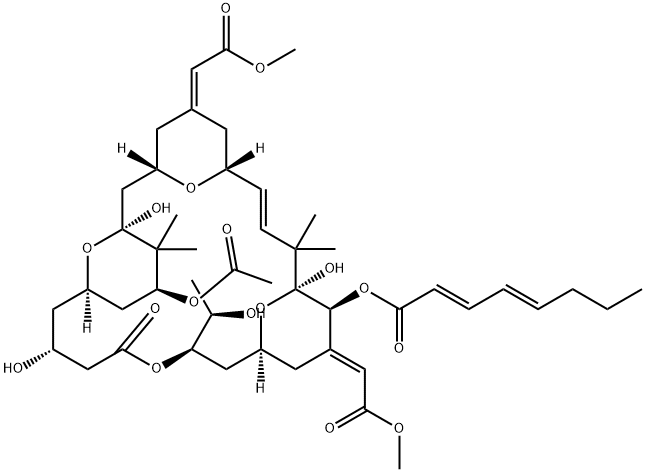83314-01-6

CHEMICAL AND PHYSICAL PROPERTIES
| Solubility | t-Butanol > 9.2 (mg/mL) |
|---|---|
| Stability/Shelf Life | Solution: Samples dissolved in PET solvent and t- Butanol showed no degradation after storage for 24 and 48 hr at ambient temperature. Samples dissolved in these same solvents showed no degradation after storage at 50 °C for 23 hr. |
SAFETY INFORMATION
| Signal word | Warning |
|---|---|
| Pictogram(s) |
 Exclamation Mark Irritant GHS07 |
| GHS Hazard Statements |
H315:Skin corrosion/irritation H319:Serious eye damage/eye irritation H335:Specific target organ toxicity, single exposure;Respiratory tract irritation H373:Specific target organ toxicity, repeated exposure |
| Precautionary Statement Codes |
P271:Use only outdoors or in a well-ventilated area. P280:Wear protective gloves/protective clothing/eye protection/face protection. P312:Call a POISON CENTER or doctor/physician if you feel unwell. |
COMPUTED DESCRIPTORS
| Molecular Weight | 905.0 g/mol |
|---|---|
| XLogP3 | 4 |
| Hydrogen Bond Donor Count | 4 |
| Hydrogen Bond Acceptor Count | 17 |
| Rotatable Bond Count | 13 |
| Exact Mass | 904.44565070 g/mol |
| Monoisotopic Mass | 904.44565070 g/mol |
| Topological Polar Surface Area | 240 Ų |
| Heavy Atom Count | 64 |
| Formal Charge | 0 |
| Complexity | 1830 |
| Isotope Atom Count | 0 |
| Defined Atom Stereocenter Count | 11 |
| Undefined Atom Stereocenter Count | 0 |
| Defined Bond Stereocenter Count | 5 |
| Undefined Bond Stereocenter Count | 0 |
| Covalently-Bonded Unit Count | 1 |
| Compound Is Canonicalized | Yes |
PRODUCT INTRODUCTION
description
Bryostatin 1 is a member of the class of bryostatins that is (17E)-2-oxooxacyclohexacos-17-ene which is substituted by hydroxy groups at positions 4, 10, and 20; an acetoxy group at position 8; methyl groups at positions 9, 9, 18, and 19; 2-methoxy-2-oxoethylidene groups at positions 14 and 24; an (E,E)-octa-2,4-dienoyloxy group at position 21; and with oxygen bridges linking positions 6 to 10, 12 to 16, and 20 to 24. It is one of the most abundant member of the class of bryostatins. It has a role as a marine metabolite, a protein kinase C agonist, an alpha-secretase activator, an antineoplastic agent and an anti-HIV-1 agent. It is a member of bryostatins, an acetate ester, a methyl ester, an enoate ester, a cyclic hemiketal, an organic heterotetracyclic compound and a secondary alcohol.